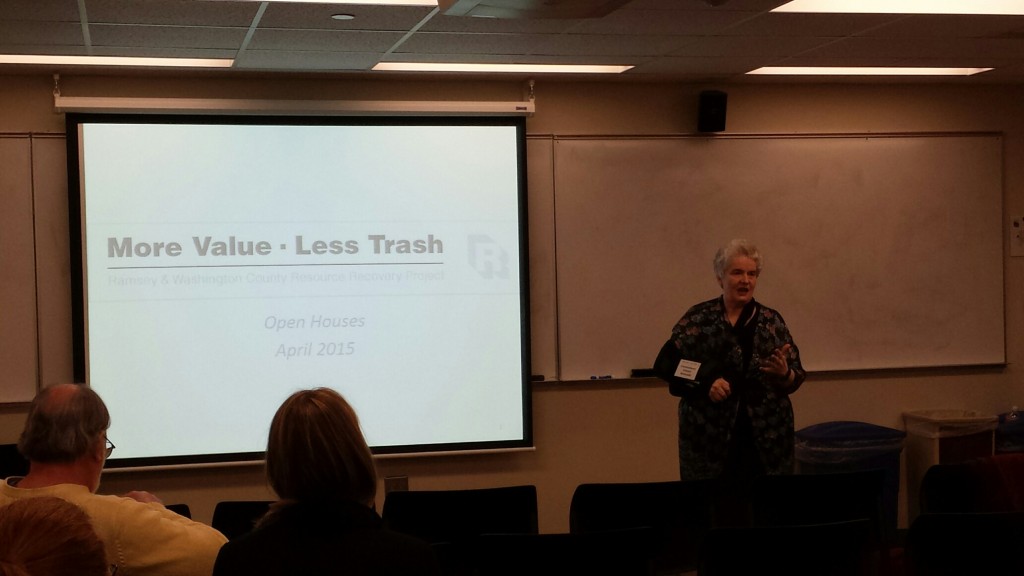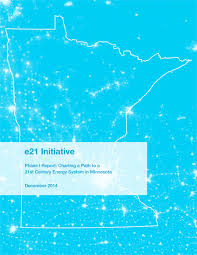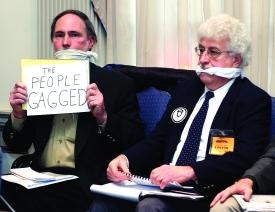GARBAGE made for a busy day!!!
April 21st, 2015
There’s the Garbage Queen Victoria Reinhardt, Ramsey County Commissioner, promoting the Joint Powers of Ramsey and Washington County’s dream of buying a RDF processing facility in Newport, one that’s now a private entity that they’re contracted with to handle their garbage! Why buy it? Why lock the counties into decades of grinding up garbage? They couldn’t answer that.
And it’s a bit of a conflict, as after they grind it up and turn garbage into RDF, they send it down here to burn it. Thanks Ramsey & Washington Counties. Let’s be clear here — you need to deal with YOUR garbage problem, and not send it to us, and not put it in our lungs.
They talked some about “what ifs,” like dreams/nightmares of anaerobic digestion and garbage gasification, but that is not dealing with their problem. It’s an issue of REDUCTION, REUSE, RECYCLING. How difficult is that?
Here’s their site and read between the lines for the plan:
Last night’s meeting was at Century College, which was 916 Area Vo-Tech when I went there and emerged in 1983 with a Truck Driver Certificate and the first of a few jobs of over the road driving that got me through a BA at Metro State! It’s changed a lot, big expansion, and the trucks are no longer there up against 694.
The next “Talkin’ Trash” garbage open houses will be 6:30 to 7:30 p.m.:
• Tuesday, April 21, in the Marsden Room of the Ramsey County Department of Public Works building, 1425 Paul Kirkwold Drive in Arden Hills.
• Thursday, April 23, in lower level conference room 14 at the Washington County Government Center, 14949 62nd St.t N., Stillwater.
• Monday, April 27, in at the Newport City Hall, 596 Seventh Ave., Newport.
• Tuesday, April 28, in Auditorium A of the Wilder Foundation, 451 Lexington Parkway N. in St. Paul.
Here are the latest reports that they’ve generated… they lose it by only looking at burning or landfilling — there’s a much wider range of options. And the Foth Report (first up) should make you froth:
Foth Analysis of Mixed Waste Processing
This study examines the potential of adding Mixed Waste Processing Technology at Newport and the costs associated with adding the technology.
Report
Ownership Analysis
This analysis includes looking at the current Municipal Solid Waste (MSW) processing facility and also looking at other technologies that may be used to process MSW.
Analysis
Governance Report
This policy study investigates the governance options available to the counties, describes the process to implement and consequences associated with each.
Report
Waste Delivery Assurance Analysis and Options
This document provides an overview of options for assuring delivery of mixed municipal solid waste, and potentially other solid wastes, to the Newport Refuse Derived Fuel (RDF) Facility or another resource recovery facility involving Ramsey and Washington Counties.
Report
Technology Comparative Analysis
This report compares the three options analyzed in the Preliminary Resource Recovery Feasibility Report to the current RDF System and to landfilling.
Report
Preliminary Resource Recovery Feasibility Report
This report addresses the technologies selected for continued evaluation by the Ramsey/Washington Counties Resource Recovery Project as part of the future of waste processing decision process.
Report
Just filed Petition for Intervention in Xcel’s e21 Docket
February 4th, 2015
Yes, I’ve filed this under “Energy” “Disaster” because it’s a train wreck of a proposal, and I cannot believe people would buy into this… or sell out into this. What, you say? e21!
In December, Xcel filed this, and I swear, this was the heading:
REQUEST FOR PLANNING MEETING AND DIALOGUE ROADMAP FOR SUPPORTING THE e21 INITIATIVE
“Roadmap for SUPPORTING?” Really…
So what is it? It’s a lot of whining about how hard it is to be a utility and that things are changing. Ummmmm… yeah. As if Xcel didn’t know that?
It feels to me like it’s another whack at “restructuring,” a/k/a deregulation, and a “we’re too big to fail” argument. And as before with “restructuring,” everyone’s getting in line, jumping on the bandwagon.
Listen to this recommendation:
(J)1. Encourage the use of, and give additional weight to, settlement agreements among parties, as long as the Commission determines that the agreements are in the public interest.
Really…
And now that we’ve permitted and built all this excess transmission capacity, they’re whining about under-utilization… can you believe it? Check this recommendation:
(N) Identify and develop opportunities to reduce customer costs by improving overall grid efficiency. In Minnesota, the total electric system utilization is approximately 55 percent (average demand divided by peak demand), thus providing an opportunity to reduce system costs by better utilizing existing system assets (e.g., generation, wires, etc.).
This sounds like the best opening to get into the CapX and MVP dockets and get them revoked. Give me a break…
So I just filed this, we’re gonna do what we can:
Why file for intervention? Well, this thing is all about stakeholders, and argues that, hey, look, all the stakeholders agree so just do it. Ummmm… right… and just who are the stakeholders? Those who have made those agreements with them in the past that got us right where we are today, DOH! What a fine mess you’ve gotten us into… let’s not do it yet again!
Delaware Audubon to give Alan Muller its Conservation Award
November 21st, 2012
Delaware Audubon Society will give Alan Muller its Conservation Award at its Annual Dinner, coming up on December 7, 2012. Alan doesn’t like to toot his own horn, but that’s part of what I’ve got a blog for! Please join us at the Annual Meeting and Dinner!
205 N. Market Street, Wilmington, DE
If the link doesn’t work, go to the Annual Dinner site!
What’s the Conservation Award? Well, in this case, maybe it’s a thank you, maybe it’s a send-off, maybe they’re just glad to see Alan spending so much time in Minnesota, but whatever it is, it’s recognition of all that he’s done in Delaware.
Special thanks to Matt Del Pizzo and Linda Whaley who are working so hard to pull this together. Alan and Matt got a lot done back when Matt was head of Audubon not so long ago, and appreciated their ability to work together to make a difference in Delaware.
As a recipient of the Conservation Award, Alan’s in interesting company — we’re especially partial to 1988’s Jake Kreshtool, he’s pretty much adopted us and is the best mentor of activism we could hope to find in Delaware, an attorney who was on the Steering Committee of Green Delaware, and way way back, he fought the big transmission line crossing the Delaware River at New Castle. Here’s their list of past recipients:
|
Past Honorees:
|
|
| 2011 | Howard P. Brokaw |
| 2010 | Andy Ednie |
| 2009 | Chad Tolman |
| 2008 | Citizens for Clean Power |
| 2007 | Debbie Heaton |
| 2006 | Andy Urquhart |
| 2005 | Richard and Lorraine Fleming |
| 2004 | Warren Lauder |
| 2003 | Albert S. Matlack |
| 2002 | Ann Rydgren |
| 2001 | Thomas Sharp |
| 2000 | Lynn Williams |
| 1999 | Edward W. Cooch, Jr. |
| 1998 | Dorothy Miller |
| 1997 | Grace Pierce-Beck |
| 1996 | Russell Peterson |
| 1995 | Winston Wayne |
| 1994 | Joseph R. Biden, Jr. |
| 1993 | Ruth Ann Minner |
| 1992 | Leah Roedel |
| 1991 | Barbara Lundberg |
| 1990 | Don Sharpe |
| 1989 | Til Purnell |
| 1988 | Jacob Kreshtool |
| 1987 | Rick West |
| 1986 | Gwynne Smith |
| 1985 | Lynne Frink |
| 1984 | Peggy Jahn |
Here are two profiles of Muller:
The Eco-Activists – Alan Muller Profile
A Profile of Alan Muller of Port Penn: An Environmental Activist and Director of Green Delaware
A look at the work of Muller and Green Delaware shows how much he’s gotten done in a difficult environment, particularly Alan’s favorite accomplishment, Delaware’s legislative ban of incineration.
www.greendel.org
Alan speaking at Macalaster for Neighbors Against the Burner:
Alan officing at Itasca State Park:
Alan at the raw sewage outlet (where’s that photo of him in his jailbird suit behind these bars?):
It’s the 4th of July
July 4th, 2012
I’ve been noticing this for a while now, people may laugh, dismiss it, but it’s very real. CORN IS GETTING BIGGER FASTER, sooner in the year, because they’re planting earlier, and by the time the 4th rolls around, the corn is way high. Now I realize this is off a bit, because we took this on June 30th, so imagine it a bit taller today:
Does that look knee high to you?
Alan was in Huff Post Monday!
July 4th, 2012
Alan Muller had a few more minutes of recognition for his work against incinerators.
The MPCA made its decision at the Board’s June 26 meeting, Alan’s testimony is kick-ass as usual, starting around 2:47. The Cottage Grove part starts about an hour into the webcast:
This time, it’s the Cottage Grove 3M Incinerator in Huffington Post this week:

(that’s a NAB sign out in front of our house, Barn Bluff visible way down the hill in the distance…)
3M Incinerator Can Burn Outside Hazardous Waste, Minnesota Says In Defeat For Residents
Bets Thorkelson’s opposition to 3M Co.’s hazardous waste incinerator began in the mid-1990s, when she learned that four moms of boys on her sons’ hockey team had breast cancer.
“About the same time, I had also noticed that many people on my street were starting to die of cancer, including a young boy from a form of lymphoma,” said Thorkelson, who lives in what she describes as a blue-collar neighborhood in Cottage Grove, Minn., about two miles from one of the St. Paul-based mega-corporation’s factories.
Her distrust of 3M grew when she received a diagnosis of breast cancer herself a decade later. And it mounted further when she heard about the company’s plans to truck in additional hazardous waste to use as fuel for an incinerator.
Last week, after three years of public meetings, petitions and pleas from Thorkelson and other residents, the Minnesota Pollution Control Agency approved a permit to burn non-3M waste, as well as materials confiscated by local law enforcement agencies, allowing the company to save as much as $2 million in natural gas. Neighbors said they fear it will add lead, mercury and other toxic pollutants to the air they breathe — on top of the water and soil contamination already blamed on the company.
No link has been proven between past 3M pollution and cases of cancer. However, the state of Minnesota is suing 3M over claims that the company polluted groundwater and surface water for more than 50 years with perflurochemicals, which scientific studies have suggested may cause cancer.
“The [incinerator] decision is very disappointing, though not surprising,” Thorkelson said. “Our community has now become the toxic dumping ground for U.S. industries.”
Knowing the permit would be controversial, the state Pollution Control Agency decided to involve residents in discussions concerning the permit, according to the agency’s Jeff Smith. “At the heart of the issue was whether the public felt like they were enough part of the process so that they were informed and had a say,” Smith said. “Over 15 additional restrictions that might not otherwise have been required were negotiated between citizens, the city and the company. At end of the day, we overachieved in involving the public.
“There will be no additional increases in pollutants beyond what 3M has been permitted to emit,” added Smith.
Representatives from 3M also emphasized that the air pollution coming out of their incinerator with the additional hazardous waste would not rise above historic levels , thanks mostly to updated equipment that traps most of the particles.
But are the regulatory limits enough to protect Cottage Grove children from developmental problems, asthma, even cancer? And were 3Ms historic pollution levels ever safe?
Alan Muller, who once promoted incinerators for DuPont, said he shares the community’s concerns over uncertain answers to both questions. He now helps advise opposition groups, including the Coalition of Concerned Cottage Grove Citizens.
“For every pound of lead that goes into the incinerator, a pound comes out,” said Muller. Toxic metals can’t be broken down like other particles, he explained, so they will either spew from the smokestack, end up in the ash that’s trucked to a landfill, or get treated with the plant’s scrubber water before winding up in the Mississippi River.
A little lead can potentially cause a lot of harm, especially to a child’s developing brain. The U.S. Centers for Disease Control and Prevention recently acknowledged the risks by lowering the threshold for lead poisoning.
“It’s not that hard to find out hazardous waste incinerators are a bad scene. But this is a political, not a tech, issue,” said Muller. “The idea of weakening environmental regulations to revive the economy is not localized. Unfortunately, the same bogus arguments continue to be made all over the country.
“I never had a feeling that MPCA was acting in good faith on this,” Muller added. “Whenever you have a powerful corporation, with a lot of clout in the state, it’s hard for regulators to stand up to them.”
Fred Luden, a resident of Cottage Grove and a former 3M employee, returned from vacation in time to share his concerns at last Tuesday’s final hearing. He told the MPCA that it struck him while sitting on a lake with his grandkids just what a pristine environment he enjoyed while growing up in Minnesota, and how contaminated parts of the state have become today.
“You’d like to see at some point in time the ball go back the other way, to an environment that you can pass down to your children, grandchildren, great-grandchildren — hopefully,” said Luden, a member of the board of directors for the Coalition of Concerned Cottage Grove Citizens. “And that they will enjoy the same ability to drink the water, breathe the air, grow what they want in a garden and eat the fish again.”
That’s little comfort for some families who currently live in what they said is a contaminated environment.
“I have some peace of mind,” said Thorkelson, “knowing my grandchildren do not live within a 10-mile radius of the incinerator.”








